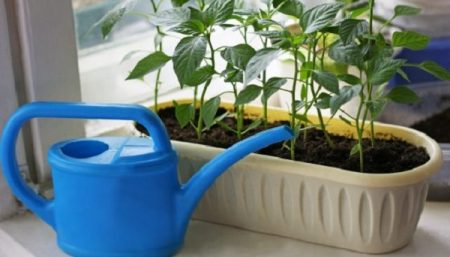
Only gardeners who know exactly how to properly water the seedlings of these crops can please themselves and loved ones with the scale of a tasty and healthy crop of tomatoes and peppers. Moreover, this applies not only to the frequency of irrigation and use of prepared water, but also to taking into account the stages of development at which seedlings are located at one time or another and the conditions for their further growth.
Content
Secrets of proper seedling watering
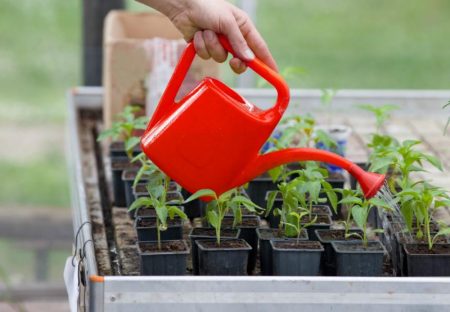
The main feature of nightshade crops is that the yield and power of the plants themselves directly depends on the state of the root part. That is why proper care for the cultivation of fruits should begin already from the moment the seeds are planted in the ground, and then continue in the process of picking seedlings and further replanting to a constant place of growth.
Features of watering planted seeds
It is important to know that the seeds planted in the ground are not watered at all. It is necessary to loosen and moisten the soil in advance, in the holes of which seeds of pepper or tomatoes will then be planted. From above, everything is sprinkled with a thin layer of dry earth and left alone (in a well-lit warm place) until the first sprouts appear.
If watering seeds that have still sprouted, water can draw them deeper into the soil or block the necessary oxygen supply, because of which the seeds may not sprout for a long time or the sprouts themselves will not appear at all on the soil surface. In an extreme case (with severe overdryness of the soil), it is possible to neatly spray warm room temperature water through the use of a spray gun.
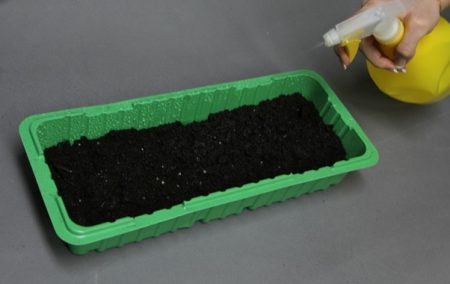
Rules for watering ascended seedlings
Watering small still immature sprouts should be with extreme caution and must take into account the thickness of the soil. If seedlings are grown on soil with a thickness of not more than 3-4 cm, it will be quite sufficient to periodically replenish the water supplies in the pan or at the very bottom of the pot.
For higher soil layers, experienced gardeners recommend the use of syringes, from which the soil will be moistened at a depth of 4-6 cm. This procedure should be carried out no more than once every 6-8 days. The topmost layer of soil is best left loose and dry, which will protect even small and immature seedlings from the manifestation of a disease such as a black leg. It is an excess of water that leads to a blockage of oxygen access to developing roots and blackening of the root of the seedlings.
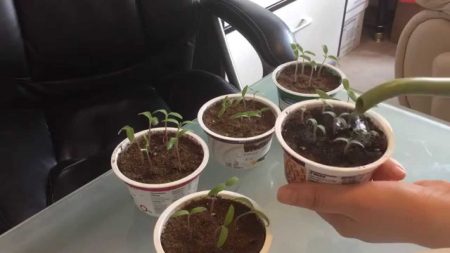
To observe the degree of soil moisture, you can plant seeds on seedlings in containers with transparent walls. The next watering is best done only after the moisture is pulled to the roots, and the soil at the edges becomes dry. In any case, it is important to remember that for growing nightshade crops, a lack of water is always better than an overabundance of it. In this case, the soil should be dry, but not dry.
Recommendations for watering seedlings after a dive
The first picking of seedlings is recommended after the formation of 2-4 full (not cotyledon) leaflets on the sprouts. The last watering before the planned dive should be carried out no later than two days later.This will allow the soil itself to be moderately moist and necessarily crumbly at the time of separation of the root systems, which will protect them from excessive loss of lateral roots.
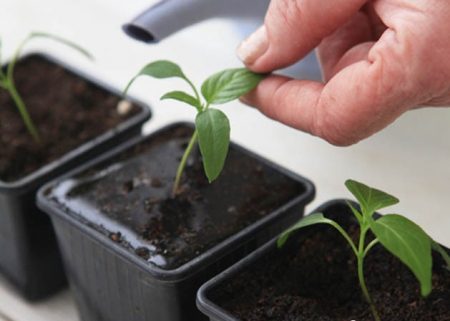
Seedlings should be transplanted into already moistened ground, since the next watering is possible only after four days. This is necessary so that the roots are more quickly and better accustomed to the new conditions, and then they can already consume useful substances for the further growth of nightshade crops. This will allow you to grow more developed and stronger seedlings. The frequency of further watering is limited to 10-day breaks. It is better if the container, where tomatoes and peppers will continue to grow, has openings at the bottom, and the container itself is installed on an additional tray, where excess moisture will go.
If at the stage of the appearance of the first sprouts seedlings it is recommended to spray the soil and the plants themselves with a spray gun, then after the first dive, watering should be carried out so that only the soil is moistened, without affecting the leaves and stems of the plants.
Rules for watering seedlings in a greenhouse
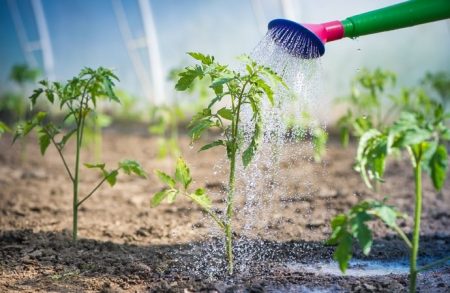
When planting bushes of tomatoes and peppers in a greenhouse, it is recommended to water immediately in the process of forming holes and falling asleep to the root of the plants. The next watering is possible no less than a week later (preferably about 8 - 10 days). Further, in the spring period it is recommended to irrigate with the expectation of 2-3 liters of water per bush once a week. With the onset of summer heat, more frequent watering is allowed - every 3 to 5 days. Watering itself is best done in the early morning or late evening. After abundant watering, it is recommended to thoroughly loosen the soil.
Features of watering seedlings after planting in the ground
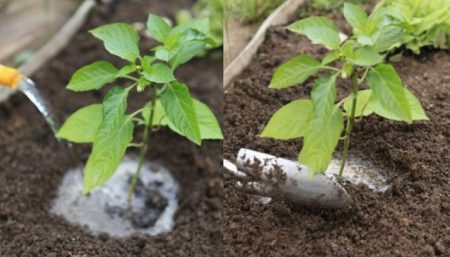
The last full watering of seedlings before planting is carried out no later than 2 to 3 days. A few hours before the planned dive, the soil is quite abundantly watered with water, and the plants themselves with their roots carefully get together with a lump of earth.
The first irrigation of already planted bushes of tomatoes and tomatoes on the open ground can be carried out, not earlier than after 10 - 15 days. After this, the next watering should take place after every 4 to 7 days of a break. As for the amount of water itself, it is worth focusing on average at a volume of 3 - 3.5 liters for each forming bush. A little more water is needed if tomatoes and peppers are grown in southern regions with hot climates. For maximum efficiency after such irrigation, it is recommended to loosen the soil at 6 - 8 cm depth.
How to determine a sufficient level of soil moisture
Since the soil for growing pepper and tomato seedlings should always be moderately moist, it is important to determine the appropriate level in advance. If the seedlings are in dry soil, it can stop in its further development, which means that the harvest will no longer be so large-scale and succulent. At the same time, the other extreme - constantly excessively moist soil - can cause root decay and complete damage to the plants themselves. Prevention of excessive accumulation of water are drainage holes that are made at the very bottom of the tank to pass excess water.
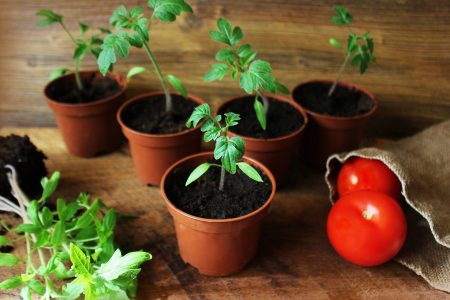
There are two ways to check for sufficient soil moisture:
- Using a spoon or a wide spatula, get a small handful of earth from the depth of the container and try to form a ball out of it. Water is enough if the ball remains integral and does not fall apart, otherwise - there is not enough water for the full development of seedlings.
- Using a wooden stick or just with your finger, make a depression of 5 - 7 cm, and then pull it out. The finger or stick should be wet and dirty. If the result is dry, then the abundance of irrigation should be increased or the interval between the irrigation itself should be shortened.
Features of water treatment
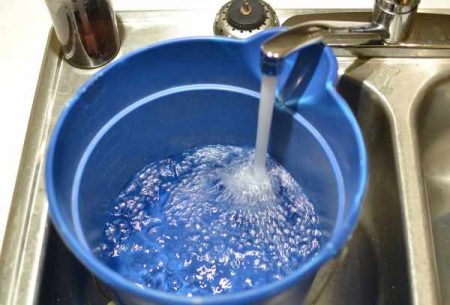
Regardless of the stage of development of seedlings of nightshade crops, in particular peppers and tomatoes, water for irrigation is considered suitable if it is settled and warm (room temperature). If irrigation is carried out with ordinary water from the central water supply, it is recommended to carry out its additional purification with special filters for drinking liquid. Water should settle for at least 8 - 10 hours, so it is better to collect it in the prepared containers in the evening and cover it, and in the morning you can use it for watering seedlings.
Alternatively, melt water can be used. To this end, ordinary water is collected in bottles or any other convenient container and left in the freezer until it is completely frozen. After that, all containers must be removed from the freezer and allowed to completely melt the ice at room temperature. Before irrigation, the water should not only completely melt, but also be warm (room temperature). Otherwise, still fragile seedlings can die from lesions with a black leg.
Errors gardeners, because of which the seedlings are pulled
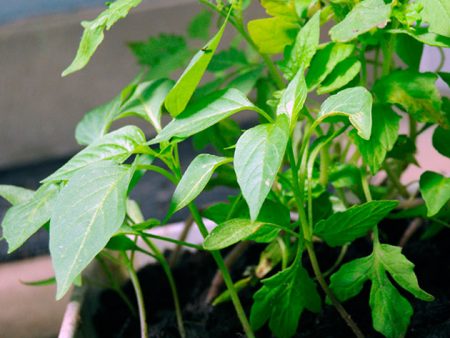
Elongated weakened seedlings of peppers and tomatoes can be obtained if you do not follow the basic rules for its cultivation. This primarily concerns:
- insufficient lighting;
- too small a distance between the holes with seeds or seedlings;
- excessively frequent and heavy irrigation;
- improperly selected temperature conditions.
To timely correct the situation with increased air temperature, you should place the containers with seedlings in a cooler place. Many gardeners recommend the use of special preparations to strengthen and stimulate (regulate) the further growth of seedlings, but in such cases, the grown seedlings, and hence the harvest, will not be any different from ordinary tomatoes and peppers that cannot be called environmentally friendly and clean. That is why you should take care of the appropriate conditions for further work with seedlings in advance.
Features of irrigation with fertilizers
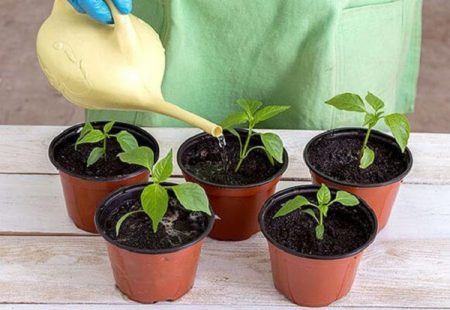
Once every 3 to 4 weeks, it is allowed to add fertilizers to the water, followed by watering the seedlings and its direct strengthening. For this, special mineral complexes or organic substances, for example, mullein or sifted wood ash, can be used.
In the first case, it is important to observe the ratio of the complex with water (not more than 1 to 10), since an excess of chemical composition can cause burns and further damage to the root systems of seedlings. In the situation with mullein and wood ash, it is necessary to use clean settled liquid (a liter of substance per bucket of water). Watering should be done not basal part of the soil, without touching the green leaves and stems.




 Low-growing tomatoes, without pinching: 5 of the most delicious varieties
Low-growing tomatoes, without pinching: 5 of the most delicious varieties Why tomato seedlings grow poorly
Why tomato seedlings grow poorly We grow a tomato in a shell
We grow a tomato in a shell Growing tomatoes without watering according to the method of Kazarin
Growing tomatoes without watering according to the method of Kazarin